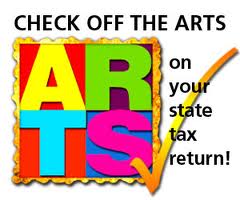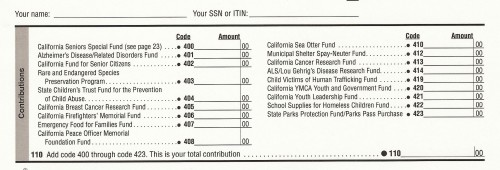State Voluntary Tax Check-Offs Grow — But Should They?
The California Arts Council gets a second chance at a tax check-off under legislation approved September 30 by Gov. Jerry Brown who created the council when he was previously governor in 1975.
It’s one of seven bills approved by lawmakers this year relating to the voluntary contribution funds, fixtures on state tax forms for 30 years. This is the third of the seven signed by the Democratic governor.
When Brown OK’d an earlier bill creating a new check-off for the “Protect Our Coast and Oceans” Fund, he bucked the advice of his own Department of Finance which said the measure was “of limited value as there is nothing currently preventing California taxpayers from contributing directly to this cause if they so choose.”
The department isn’t alone in questioning the efficacy of the 18 – now 20 — check-offs, which support everything from breast cancer research and sea otters to state parks and school supplies for homeless children.
“It is not clear that the tax check-off program, as currently administered, is an efficient and effective strategy to connect donors and charitable organizations,” writes the Senate Governance & Finance Committee in its analysis of one of this year’s check-off bills.
 The committee notes in each of its analyses of this year’s tax check-off legislation that in 2012 the Franchise Tax Board reported receiving total check-off contributions of $4.7 million from 89,335 of the state’s 15 million taxpayers.
The committee notes in each of its analyses of this year’s tax check-off legislation that in 2012 the Franchise Tax Board reported receiving total check-off contributions of $4.7 million from 89,335 of the state’s 15 million taxpayers.
In contrast, Californians make $17 billion in charitable contributions annually, according to 2008 data compiled by the Chronicle of Philanthropy. That’s the highest amount of any state.
“Countless worthy causes may be funded by tax check-offs. The current system remains subjective and is limited to those organizations that can convince the Legislature to include them on the form. These check-offs give the state a role in collecting money for charity in addition to the role the tax system plays in allowing deductions for charitable contributions. The current design and administration of the existing tax check-off program raises a number of concerns that suggest the need for a different approach,” the committee concludes.
Since 2000, state general fund support of the arts council has fallen from $25 million to $5 million. The new “Keep Arts in Schools” check-off is aimed at attracting additional funding for in-school programs sponsored by the council.
A previous check-off allowing taxpayers to tithe some of their refund to the council appeared on the 2010 tax form but was removed in 2012 because the tax board estimated it wouldn’t reach the $250,000 minimum contribution level needed to remain.
In its final year on the tax form, the council received $165,647 in contributions.
An Assembly analysis of the bill creating the new “Keep Arts in Schools” check-off says the new name is designed to create “improved marketability.” Or as the Senate Governance & Finance Committee says: “A rose by any other name.”
The bill – SB 571 by Sen. Carol Liu, a Flintridge Democrat – was signed by Brown without comment.
He has yet to decide whether to add another check-off supporting California chapters of the Red Cross.
The 18 current check-offs can be found at the top of Page 3 of California’s 540 tax forms.
For several years, space limits held the number of check-offs in check at a maximum of 15. New ones had to wait until existing ones expired. Most check-offs automatically expire after five years but space on the form often opened up sooner when check-offs didn’t meet the $250,000 annual contribution minimum.
Among those check-offs recently repealed for insufficient contributions were funds benefitting the Police Activities League and supporting programs encouraging the safe surrender of infants to authorities.
The increase in electronic filing and a redesign of the tax form have ended concerns over space. What were 15 check-offs climbed to 18 and now could be 21, depending how Brown acts on the Red Cross check-off.
Another 12 to 15 check-offs can still be added before the tax board says it needs to spend $1 million to change its system to accommodate more.
 The “Protect Our Coast and Oceans Fund,” will pay for grants to groups conducting “innovative ‘adopt-a-beach’ programs.”
The “Protect Our Coast and Oceans Fund,” will pay for grants to groups conducting “innovative ‘adopt-a-beach’ programs.”
Noted Brown’s Department of Finance:
“It is not clear that a special preference should be given to the grants and programs supported by this tax check-off as compared to other organizations also dedicated to preserving and enhancing California’s coastal resources.”
Brown has also signed a bill allowing the Emergency Food Assistance Program to stay on the tax form an additional five years until 2019.
Among the other check-off related bills on Brown’s desk are measures extending the repeal date for the California Fund for Senior Citizens and the Alzheimer’s Disease and Related Disorders Research Fund from 2015 to 2020.
-30-
Filed under: Governor, Legislature/Legislation
- Capitol Cliches (16)
- Conversational Currency (3)
- Great Moments in Capitol History (4)
- News (1,288)
- Budget and Economy (383)
- California History (139)
- Demographics (11)
- Fundraising (74)
- Governor (122)
- Legislature/Legislation (270)
- Politics (173)
- State Agencies (38)
- Opinionation (36)
- Overheard (246)
- Today's Latin Lesson (45)
- Restaurant Raconteur (21)
- Spotlight (110)
- Trip to Tokyo (8)
- Venting (184)
- Warren Buffett (43)
- Welcome (1)
- Words That Aren't Heard in Committee Enough (11)

When Assemblyman Art Agnos proposed a tax check-off for the Senior Legislature in the early ’80s, he argued its merits and its one-of-a-kind financial boost. But Greg’s article confirms an iron law of legislating: alls bills are precedents. See prison sentences, tax deductions, vanity license plates, California State ___(fill in the blank),etc.
Comment by Patrick Johnston — 10.01.2013 @ 11:29 am